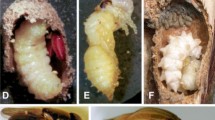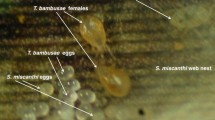Abstract
Food limitation can reduce reproductive success directly, as well as indirectly, if foraging imposes a risk of predation or parasitism. The solitary bee Osmia pumila suffers brood parasitism by the cleptoparasitic wasp Sapyga centrata, which enters the host nest to oviposit while the female bee is away. I studied foraging and reproduction of O. pumila nesting within cages stocked with rich or sparse floral resources, and the presence or absence of S. centrata to test (1) the response of nesting female O. pumila to food shortages, (2) the response of nesting female O. pumila to the presence of parasites, and (3) whether brood produced under scarce resources are more likely to be parasitized by S. centrata. The rate of brood cell production was significantly lower in cages with sparse floral resources, although females in sparse cages did not produce significantly fewer brood cells overall. Sapyga centrata did not influence the rate of brood cell production, but females exposed to the cleptoparasites had marginally significantly lower reproductive output. Nests in parasite cages had significantly fewer brood cells than those in parasite free cages. The mean duration of foraging bouts made by female O. pumila in sparse cages was not significantly longer than that in rich cages. O. pumila spent less time in the nest between pollen and nectar foraging bouts in sparse cages with S. centrata than those in other cages suggesting that these individuals made more frequent food foraging trips. Despite the weak effects of parasites and bloom density on foraging behavior, O. pumila brood cells experienced a 15-fold higher probability of parasitism by S. centrata in cages with sparse bloom than in those with rich bloom. These results support the hypothesis that indirect effects of food scarcity increase O. pumila susceptibility to brood parasitism, although the exact mechanism is not entirely clear yet.





Similar content being viewed by others
References
Abrams PA (1993) Indirect effects arising from optimal foraging. In: Kawanabe H, Cohen JE, Iwasaki K (eds) Mutualism and community organization: behavioral, theoretical, and food-web approaches. Oxford University Press, Oxford, pp 255–279
Andersson M (1984) The evolution of eusociality. Annu Rev Ecol Syst 15:165–189
Barthell JF, Frankie GW, Thorp RW (1998) Invader effects in a community of cavity nesting megachilid bees (Hymenoptera: Megachilidae). Environ Entomol 27:240–247
Bowers MA (1990) Exploitation of seed aggregates by Merriam's kangaroo rat: harvesting rates and predatory risk. Ecology 71:2334–2344
Clark AB (1978) Sex ratio and local resource competition in a prosimian primate. Science 201:163–165
Danforth BN, Visscher PK (1993) Dynamics of a host-cleptoparasite relationship: Holcopasities ruthae as a parasite of Calliopsis pugionis (Hymenoptera: Anthophoridae, Andrenidae). Ann Entomol Soc Am 86:833–840
Durrer S, Schmid-Hempel P (1994) Shared use of flowers leads to horizontal pathogen transmission. Proc R Soc Lond B 258:299–302
Eickwort GC, Ginsberg HS (1980) Foraging and mating behavior in Apoidea. Annu Rev Entomol 25:421–446
Eickwort GC, Eickwort JM, Gordon J, Eickwort MA (1996) Solitary behavior in a high-altitude population of the social sweat bee Halictus rubicundus (Hymenoptera: Halictidae). Behav Ecol Sociobiol 38:227–233
Evans HE (1966) The accessory burrows of digger wasps. Science 152:465–471
Evans HE (1977) Extrinsic versus intrinsic factors in the evolution of insect sociality. BioScience 27:613–617
Gathmann, A, and Tscharntke, T (2002) Foraging ranges of solitary bees. J Anim Ecol 71:757–764.
Gilliam JF, Fraser DF (1987) Habitat selection under predation hazard: test of a model with foraging minnows. Ecology 68:1933–1942
Goodell K (2000) The impact of honey bees on native solitary bees: competition and indirect effects. PhD Dissertation, State University of New York, Stony Brook, N.Y.
Gotceitas V (1990) Foraging and predator avoidance: a test of a patch choice model with juvenile bluegill sunfish. Oecologia 83:346–351
Graenicher S (1906) A contribution to our knowledge of the visual memory of bees. Wis Nat Hist Soc Bull 4:135–142
Hobbs GA, Krunic MD (1971) Comparative behavior of three chalcidoid (Hymenoptera) parasites of the alfalfa leafcutter bee, Megachile rotundata, in the laboratory. Can Entomol 103:674–685
Kerfoot WB (1967) The lunar periodicity of Sphecodogastra texana, a nocturnal bee (Hymenoptera: Halictidae). Anim Behav 15:479–486
Kim J-Y (1997) Female size and fitness in the leaf-cutter bee Megachile apicalis. Ecol Entomol 22:275–282
Kim J-Y (1999) Influence of resource level on maternal investment in a leaf-cutter bee (Hymenoptera: Megachilidae). Behav Ecol 10:552–556
Krombein KV (1967) Trap-nesting wasps and bees: life histories, nests, and associates. Smithsonian Press, Washington, D.C.
Lima SL, Dill LD (1989) Behavioral decisions made under the risk of predation: a review and prospectus. Can J Zool 68:619–640
Lin N (1964) Increased parasite pressure as a major factor in the evolution of social behavior in halictine bees. Insectes Soc 11:187–192
Lin N, Michener CD (1972) Evolution of sociality in insects. Q Rev Biol 47:131–159
Linsley EG (1958) The ecology of solitary bees. Hilgardia 27:543–599
Linsley EG, MacSwain JW (1952) Notes on some effects of parasitism upon a small population of Diadasia bituberculata. Pan-Pac Entomol 28:131–135
Linsley EG, MacSwain JW (1955) The habits of Nomada opacella Timberlake with notes on other species (Hymenoptera: Anthophoridae). Wasmann J Biol 13:253–276
Linsley EG, MacSwain JW, Raven PH (1963) Comparative behavior of bees and Onagraceae I. Oenothera bees of the Colorado desert. Univ Calif Pub Entomol 33:1–24
Michener CD (1953) The biology of a leafcutter bee (Megachile brevis) and its associates. Univ Kan Sci Bull 35:1569–1584
Michener CD (1955) Some biological observations on Hoplitis pilosifrons and Stelis lateralis (Hymenoptera: Megachilidae). J Kans Entomol Soc 28:81–87
Michener CD (1964) The evolution of nests of bees. Am Zool 4:227–239
Michener CD (1985) From solitary to eusocial: need there be a series of intervening species? In: Hölldobler B, Lindauer M (eds) Experimental behavioral ecology and sociobiology. Fischer, Stuttgart, Germany, pp 293–305
Michener CD (2000) The bees of the world. Johns Hopkins University Press, Baltimore, Md.
Munster-Swendsen M, Calabuig I (2000) Interaction between the solitary bee Chelostoma florisomne and its nest parasite Sapyga clavicornis - empty cells reduce the impact of parasites. Ecol Entomol 5:63–70
Parker FD (1978) Biology of the bee genus Proteriades Titus (Hymenoptera: Megachilidae). J Kan Entomol Soc 51:145–173
Pate VSL (1946) The generic names of the Sapygidae and their type species (Hymenoptera: Aculeata). Entomol News 57:219–221
Richards LJ (1984) Field studies of foraging behavior of an intertidal beetle. Ecol Entomol 9:189–194
Rosenheim JA (1987a) Host location and exploitation by the cleptoparasitic wasp Argochrysis armilla: the role of learning (Hymenoptera: Chrysididae). Behav Ecol Sociobiol 21:401–406
Rosenheim JA (1987b) Nesting-Behavior and bionomics of a solitary ground-nesting wasp, Ammophila dysmica (Hymenoptera, Sphecidae) - influence of parasite pressure. Ann Entomol Soc Am 80:739–749
Rosenheim JA (1989) Behaviorally mediated spatial and temporal refuges from a cleptoparasite, Argochrysis armilla (Hymenoptera: Chrysididae), attacking a ground-nesting wasp, Ammophila dysmica (Hymenoptera: Sphecidae). Behav Ecol Sociobiol 25:335–348
Rosenheim JA (1990) Density-dependent parasitism and the evolution of aggregated nesting in the solitary Hymenoptera. Ann Entomol Soc Am 83:277–286
Rosenheim JA, Nonacs P, Mangel M (1996) Sex ratios and multifaceted parental investment. Am Nat 148:501–535
Rozen JG (1986) Natural history of the world nomadine parasitic bee Pasites maculata (Anthophoridae: Nomadinae) and its host Pseudoapis diversites (Halictidae: Nomiinae). Am Mus Novit 2861:1–9
Rozen JG (1987) Nesting biology of the bee Ashmediella holtii and its cleptoparasite, a new species of Stelis (Apoidea: Megachilidae). Am Mus Novit 2900:1–10
Rozen JG, Eickwort KR, Eickwort GC (1978) The bionomics and immature stages of the cleptoparasitic bee genus Protepeolus (Anthophoridae: Nomadinae). Am Mus Novit 2640:1–20
SAS (1999–2001) The SAS System for Windows, version 8.02. SAS Institute, Cary, N.C.
Sih A (1980) Optimal behavior: can foragers balance two conflicting demands? Science 210:1041–1043
Stone GN, Loder PMJ, Blackburn TM (1995) Foraging and courtship behavior in males of the solitary bee Anthophora plumipes (Hymenoptera, Anthophoridae): thermal physiology and the roles of body-size. Ecol Entomol 20:169–183
Tepedino VJ, Torchio PF (1982) Phenotypic variability in nesting success among Osmia lignaria propinqua females in a glasshouse environment (Hymenoptera: Megachilidae). Ecol Entomol 7:453–462
Thorp RW (1969) Systematics and ecology of bees of the subgenus Diandrena (Hymenoptera: Andrenidae). Univ Calif Pub Entomol 52:1–146
Torchio PF (1972) Sapyga pumila Cresson a parasite of Megachile rotundata (F.) (Hymenoptera: Sapygidae, Megachilidae) I. Biology and descriptions of immature stages. Melandaria 10:1–22
Torchio PF (1989) In-nest biologies and development of immature stages of three Osmia species (Hymenoptera: Megachilidae). Ann Entomol Soc Am 82:599–613
Torchio PF, Bosch J (1992) Biology of Tricrania stansburyi, a meloid beetle cleptoparasite of the bee Osmia lignaria propinqua (Hymenoptera, Megachilidae). Ann Entomol Soc Am 85:713–721
Torchio PF, Tepedino VJ (1980) Sex ratio, body size and seasonality in a solitary bee, Osmia lignaria propinqua Cresson (Hymenoptera: Megachilidae). Evolution 34:993–1003
Visscher PK, Danforth BN (1993) Biology of Calliopsis pugionis (Hymenoptera: Andrenidae): nesting, foraging, and investment sex ratio. Ann Entomol Soc Am 86:822–832
Watmough RH (1983) Mortality, sex-ratio and fecundity in natural-populations of large carpenter bees (Xylocopa spp.). J Anim Ecol 52:111–125
Wcislo WT (1984) Gregarious nesting of a digger wasp as a selfish herd response to a parasitic fly (Hymenoptera, Sphecidae—Diptera, Sacrophagidae). Behav Ecol Sociobiol 15:157–160
Wcislo WT (1987) The roles of seasonality, host synchrony, and behavior in the evolutions and distributions of nest parasites in the Hymenoptera (Insecta), with special reference to bees (Apoidea). Biol Rev 62:515–543
Wcislo WT (1996) Parasitism rates in relation to nest site in bees and wasps (Hymenoptera: Apoidea). J Insect Behav 9:643–656
Wcislo WT, Cane JH (1996) Floral resource utilization by solitary bees (Hymenoptera: Apoidea) and exploitation of their stored foods by natural enemies. Annu Rev Entomol 41:195–224
Wcislo WT, Wille A, Orozco E (1993) Nesting biology of tropical solitary and social sweat bees, Lassioglossum (Dialictus) figueresi Wcislo and L. (D.) aeneiventre Friese (Hymenoptera: Halictidae). Insectes Soc 40:21–40
Werner EE, Anholt BR (1993) Ecological consequences of the trade-off between growth and mortality rates mediated by foraging activity. Am Nat 142:242-272
Acknowledgements
I am grateful to James Thomson, Neal Williams, and Vincent Tepedino for sharing insights that improved this study. James Thomson helped design and build the cages; John Hunter, Mike Axelrod, John Klumpp, Neal Williams, Kim Baxter, André Levy, Ken Lorenz, Mark Barsamian, Patrick Baker, Bob Goodell, and Del Goodell also lent a hand with cage construction. Vincent Tepedino provided Phacelia seed. Terry Griswold (USDA Bee Biology and Systematics Laboratory, Logan, Utah) kindly identified the Osmia, and Baldo Villegas (CDFA, Biological Control Program, Sacramento, Calif.) the Sapyga. James Thomson, Doug Futuyma, Dan Simberloff, Jay Rosenheim, and two anonymous reviewers all provided comments that improved this manuscript. NSF doctoral dissertation improvement grant DEB-98–01274 funded this research.
Author information
Authors and Affiliations
Corresponding author
Additional information
An erratum to this article can be found at http://dx.doi.org/10.1007/s00442-003-1340-2
Rights and permissions
About this article
Cite this article
Goodell, K. Food availability affects Osmia pumila (Hymenoptera: Megachilidae) foraging, reproduction, and brood parasitism. Oecologia 134, 518–527 (2003). https://doi.org/10.1007/s00442-002-1159-2
Received:
Accepted:
Published:
Issue Date:
DOI: https://doi.org/10.1007/s00442-002-1159-2




